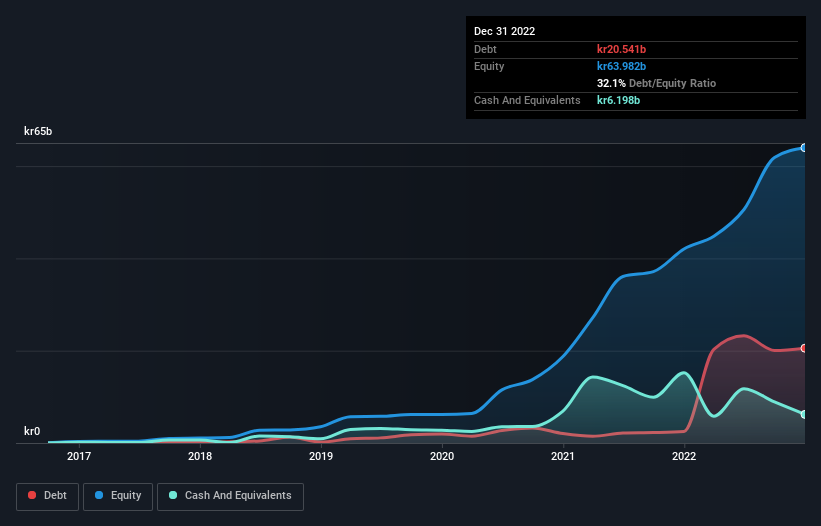
Howard Marks put it nicely when he said that, rather than worrying about share price volatility, 'The possibility of permanent loss is the risk I worry about... and every practical investor I know worries about.' It's only natural to consider a company's balance sheet when you examine how risky it is, since debt is often involved when a business collapses. Importantly, Embracer Group AB (publ) (STO:EMBRAC B) does carry debt. But the real question is whether this debt is making the company risky.
When Is Debt A Problem?
Debt is a tool to help businesses grow, but if a business is incapable of paying off its lenders, then it exists at their mercy. If things get really bad, the lenders can take control of the business. While that is not too common, we often do see indebted companies permanently diluting shareholders because lenders force them to raise capital at a distressed price. Of course, debt can be an important tool in businesses, particularly capital heavy businesses. When we examine debt levels, we first consider both cash and debt levels, together.
See our latest analysis for Embracer Group
What Is Embracer Group's Net Debt?
The image below, which you can click on for greater detail, shows that at December 2022 Embracer Group had debt of kr20.5b, up from kr2.51b in one year. However, it also had kr6.20b in cash, and so its net debt is kr14.3b.

How Healthy Is Embracer Group's Balance Sheet?
According to the last reported balance sheet, Embracer Group had liabilities of kr18.6b due within 12 months, and liabilities of kr36.2b due beyond 12 months. Offsetting these obligations, it had cash of kr6.20b as well as receivables valued at kr9.34b due within 12 months. So it has liabilities totalling kr39.2b more than its cash and near-term receivables, combined.
This deficit isn't so bad because Embracer Group is worth kr69.2b, and thus could probably raise enough capital to shore up its balance sheet, if the need arose. But we definitely want to keep our eyes open to indications that its debt is bringing too much risk. When analysing debt levels, the balance sheet is the obvious place to start. But it is future earnings, more than anything, that will determine Embracer Group's ability to maintain a healthy balance sheet going forward. So if you're focused on the future you can check out this free report showing analyst profit forecasts.
In the last year Embracer Group wasn't profitable at an EBIT level, but managed to grow its revenue by 130%, to kr38b. So there's no doubt that shareholders are cheering for growth
Caveat Emptor
Despite the top line growth, Embracer Group still had an earnings before interest and tax (EBIT) loss over the last year. To be specific the EBIT loss came in at kr3.3b. When we look at that and recall the liabilities on its balance sheet, relative to cash, it seems unwise to us for the company to have any debt. So we think its balance sheet is a little strained, though not beyond repair. However, it doesn't help that it burned through kr231m of cash over the last year. So to be blunt we think it is risky. When analysing debt levels, the balance sheet is the obvious place to start. However, not all investment risk resides within the balance sheet - far from it. These risks can be hard to spot. Every company has them, and we've spotted 1 warning sign for Embracer Group you should know about.
Of course, if you're the type of investor who prefers buying stocks without the burden of debt, then don't hesitate to discover our exclusive list of net cash growth stocks, today.
Valuation is complex, but we're here to simplify it.
Discover if Embracer Group might be undervalued or overvalued with our detailed analysis, featuring fair value estimates, potential risks, dividends, insider trades, and its financial condition.
Access Free AnalysisHave feedback on this article? Concerned about the content? Get in touch with us directly. Alternatively, email editorial-team (at) simplywallst.com.
This article by Simply Wall St is general in nature. We provide commentary based on historical data and analyst forecasts only using an unbiased methodology and our articles are not intended to be financial advice. It does not constitute a recommendation to buy or sell any stock, and does not take account of your objectives, or your financial situation. We aim to bring you long-term focused analysis driven by fundamental data. Note that our analysis may not factor in the latest price-sensitive company announcements or qualitative material. Simply Wall St has no position in any stocks mentioned.
About OM:EMBRAC B
Embracer Group
Develops and publishes PC, console, mobile, VR, and board games for the games market worldwide.
Flawless balance sheet and good value.
Similar Companies
Market Insights
Community Narratives



